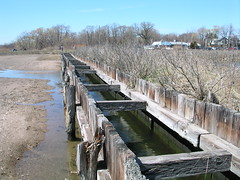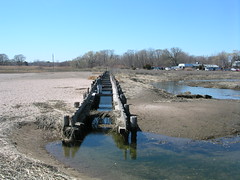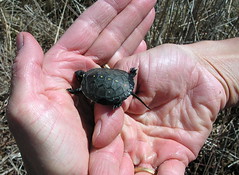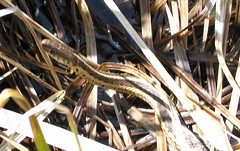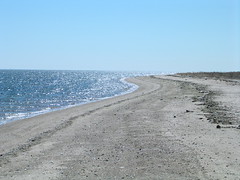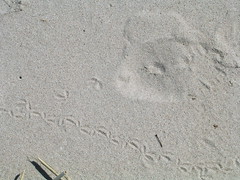Almost inevitably when I give a talk about Long Island Sound, people want to tell me about their experiences on the Sound, usually childhood experiences. People my age or older -- those who came of age in the 1950s and '60s -- invariably say the Sound was so much cleaner when they were kids. Two people told me similar tales on Saturday, after my talk at Audubon Connecticut's annual meeting. One woman, who informed me that she was older than she looked, said she could remember standing in water up to her chin at West Haven and seeing crabs and eels at her feet, as if her toes were a personal
Secchi disk (I resisted pointing out that she was probably much shorter then).
To these people, the Sound in the early 21st century is a disappointment; it's too murky to satisfy their memories of an earlier, more pristine era.
Is it possible that the water in the Sound was clearer in 1950 or 1960 than it is now? It is certainly true that the water is clearer now as you move east. Compo Beach is clearer than Rye Beach; Hammonasset is clearer than Compo; Block Island is clearer than Hammonasset. But can people's memories be trusted that the water in West Haven was clearer in, say 1950, than it is now, or are those memories fogged by nostalgia?
Having moved to the Sound area only in 1982, when I was almost 30, I don't have my own personal childhood baseline for water clarity. I remember swimming on the south shore of Staten Island, at Arbutus Beach, among other places, when I was seven, in 1961. By the following year someone realized that the city was dumping raw sewage in the area and, like that, Staten Island's beaches were closed. (In the mid 1970s I brought college friends from upstate New York there, for a look at the Bay, and was astonished at how derelict a beach could become in 15 years.) After that, our swimming was limited to the Jersey shore, where you could scoop blue crabs from the bridge abutments of the Manasquan and Metedeconk rivers, sub-estuaries of Barnegat Bay, and catch snappers from the floats at the local boatyards.
Could the Sound have been clearer 40 or 50 years ago? Estuaries are murky places in general. Diatoms, copepods, larval oysters, larval lobsters and other animals cloud the upper layers of the water. Tiny particles in sewage -- treated and untreated -- make it cloudier still. Debris carried into the Sound via stormwater makes it worse.
To go back to the question of water clarity in West Haven, where the major influence is New Haven .... Between 1950 and 2000, the population of New Haven fell from roughly 164,000 to 123,000, and the New Haven sewage treatment plant, which was one of the region's worst in the 1980s, improved.
In fact, sewage plants throughout the Sound region are better now than in the 1950s. A good percentage of treatment plants 50 years ago were operating at the primary level, which meant that they were removing only about 30 percent or so of the suspended solids -- tiny particles that don't immediately sink to the bottom -- in wastewater. After the Clean Water Act, in 1972, upgrades improved that to about 80 percent. So that alone would tend to make the water clearer.
The problem is that while New Haven has gotten smaller, the surrounding towns have gotten bigger.
While New Haven's population fell by 41,000, or 25 percent, the population of East Haven, Hamden, North Haven, Orange, West Haven, and Wallingford rose from 123,500 to 216,000, or 75 percent. Overall, 71,500 more people, or 27 percent, lived in the greater New Haven area in 2000 than in 1950.
Wastewater engineers figure than each person uses 150 gallons of water a day, essentially all of which ends up in sewage plants. If all 71,500 additional people use sewers instead of septics, the amount of wastewater treated in the area would have risen by almost 11 million gallons a day. That increase would take a large bite out of any improvements in treatment technology.
Add to that the increase in particles and contaminants from the stormwater that runs off all the new roads, driveways, houses and sidewalks in these suburban areas, and it's easy to make a case that middle-aged swimmers in Long Island Sound are probably right: the Sound was much clearer back in the old days -- the days of our childhoods.

